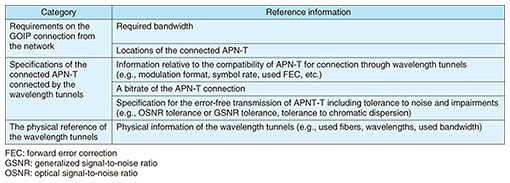 |
|||||||||||||||||
|
|
|||||||||||||||||
|
Feature Articles: Development of IOWN with Global Partners Vol. 20, No. 5, pp. 18–23, May 2022. https://doi.org/10.53829/ntr202205fa2 Study on Open All-Photonic Network in IOWN Global ForumAbstractThe IOWN Global Forum is developing the Open All-Photonic Network (Open APN) to provide direct optical paths between any location on demand to implement use cases of the Innovative Optical and Wireless Network (IOWN). This article describes the Open APN design goals and technical challenges as well as its functional architecture, with reference to the technical document “Open All-Photonic Network Functional Architecture” published in early 2022. Keywords: IOWN, Open All-Photonic Network, functional architecture 1. IntroductionThe IOWN Global Forum (IOWN GF) has released documents for two use cases, Cyber-Physical Systems (CPS) and AI-Integrated Communications (AIC). These use cases have already started to be implemented worldwide at some level. However, the evolution of sensing/capture technologies suggests that the critical requirements of these use cases will be much higher than those achievable with current technologies. IOWN GF is developing the Open All-Photonic Network (Open APN) [1] to establish an open architecture for photonic networking so that service providers can integrate photonic network functions with their entire computing and networking infrastructure with more granularity. 2. Design goals of Open APNOpen APN is being developed for achieving the following concepts:
3. Evolution of optical transport technologiesSince the commercialization of digital coherent transmission systems started around 2010, the downsizing, power saving, and control-interface commonality of transmission systems have accelerated. In 2016, with the launch of Open ROADM [2], which defines interfaces and specifications to make reconfigurable optical add/drop multiplexer (ROADM) systems interoperable among vendors, and the Telecom Infra Project Open Optical & Packet Transport (TIP OOPT) [3], which defines open technologies, architectures, and interfaces in optical and Internet protocol networking, the openness of optical transmission technologies has accelerated. The application of digital technology provides advantages such as (1) being simpler and more flexible for the transmission line and its design, (2) enabling the independent evolution of hardware and software, (3) enabling the real-time measurement of transmission quality without affecting transmission quality, and (4) enabling the rapid estimation of transmission-line characteristics that determine transmission distance and capacity by using a Gaussian noise model. Over the next ten years, the convergence of computing and networking is expected to accelerate with the advent of co-packaged optics. In fourth-generation (4G)/5G mobile networks, the bitrate of the mobile front haul (MFH) link per antenna has been enhanced to 10 or 25 Gbit/s, and there is also much discussion about standardization for applying wavelength division multiplexing (WDM) technologies to the MFH link [4, 5]. For enhancing fixed broadband access, Next-Generation Passive Optical Network Stage 2 (NG-PON2), which combines traditional time division multiplexing with dense WDM (DWDM) technology with 4 to 8 wavelengths, has been standardized and commercialized [6, 7]. Super-PON is under standardization to develop a long-distance (over 50-km) PON system through combining a 2.5G- to 10G-class PON system with DWDM technology (16 wavelengths or more) [8]. It is expected that common WDM networking will efficiently accommodate traffic in a metro-access area. 4. Technical challenges to implement Open APNTo implement Open APN, it is necessary to accelerate the further development of the technological trends described in the previous section and address the technical challenges in Table 1. The Open APN function architecture is defined with these solutions in mind, and the high-level reference architecture, control-and-management-plane architecture, and user-plane architecture are described separately.
5. Functional architecture of Open APN5.1 High-level reference architectureFigure 2 shows a high-level reference architecture of Open APN. The Open APN User plane consists of the Open APN Transceiver (APN-T), Open APN Gateway (APN-G), and Open APN Interchange (APN-I). The Open APN Control and Management plane consists of the Open APN Controller (APN-C) that communicates with the APN-T, APN-G, and APN-I.
The APN-T is an endpoint for an optical path and transmits and receives optical signals. The APN-G is a gateway for an optical path and has the following five functions: (1) provision of control channels to communicate with the connected APN-Ts, (2) admission control in the user plane, (3) multiplexing/demultiplexing, (4) turn back, and (5) add/drop. The APN-I is an interchange for wavelength switching and has the following two functions; (1) wavelength cross-connect and (2) adaptation between the interfaces. Compared with the current standard ROADM, the APN-G’s functions (1), (2), and (4) and APN-I’s function (2) can be regarded as the functions characteristic to Open APN. 5.2 Control-and-management-plane reference architectureTo implement the control-and-management plane of Open APN, as shown in Fig. 2, an Open APN Service application programming interface (API) is defined between the APN-C and external management-and-orchestration systems, and an Open APN Device API is defined between the APN-C and Open APN devices (APN-T, APN-G, and APN-I). After authentication and activation of the APN-T, the APN-C creates, deletes, or resets an optical path between the APN-Ts on demand triggered by path-setup requests. The APN-C calculates the wavelength path route, wavelength to use, transmission/reception parameters for optical transmission devices, and configuration of optical transmission devices accordingly to satisfy user requirements regarding bandwidth, latency, and jitter. The APN-C also monitors quality of transmission (QoT) information through the Open APN Device API in real time and determines whether user requirements about QoT are satisfied for each wavelength path. An example configuration of telemetry for the APN-C and Open APN devices and an example controller configuration for coordinating with the mobile system are shown in the document “Open All-Photonic Network Functional Architecture” [1]. 5.3 User-plane reference architectureThe concept of Group of Optically Interconnectable Port (GOIP) has been introduced to implement scalable and interoperable Open APNs under physical constraints such as a limited number of wavelengths and transmission distance. GOIP is defined as a group of optical ports for which a direct optical connection (Open APN optical path) can be established. The port means a connection interface between an APN-T and access link. The connection can be point-to-point and point-to-multipoint. Figure 3 shows a configuration image of GOIP.
Because the total distance of the connection depends on bitrate and/or modulation methods, these methods of the optical transmission/reception between ports in GOIP are presented for each GOIP individually. In GOIP, there is at least one route that can establish a direct optical connection between ports. However, a direct optical connection may not be established when the shortest route is not available due to reasons such as shortage of wavelength resources, fiber cut, or equipment failure. GOIP design methods given these considerations are for further study. In the Open APN architecture, wavelength tunnels should be managed appropriately in accordance with the specified bit rate and transmission distance, so a physical-layer reference architecture is defined and the physical reference of wavelength tunnels is described (Table 2).
6. Future outlooksIn IOWN GF, Open APN will evolve with a spiral approach that repeats the development of its specifications and demonstration. The Open APN functional architecture described in this article will be used as a base for proof-of-concept demonstration. The insights gained through the demonstration will be reflected in the future development of Open APN specifications and improvement in the Open APN functional architecture. References
|
|||||||||||||||||











